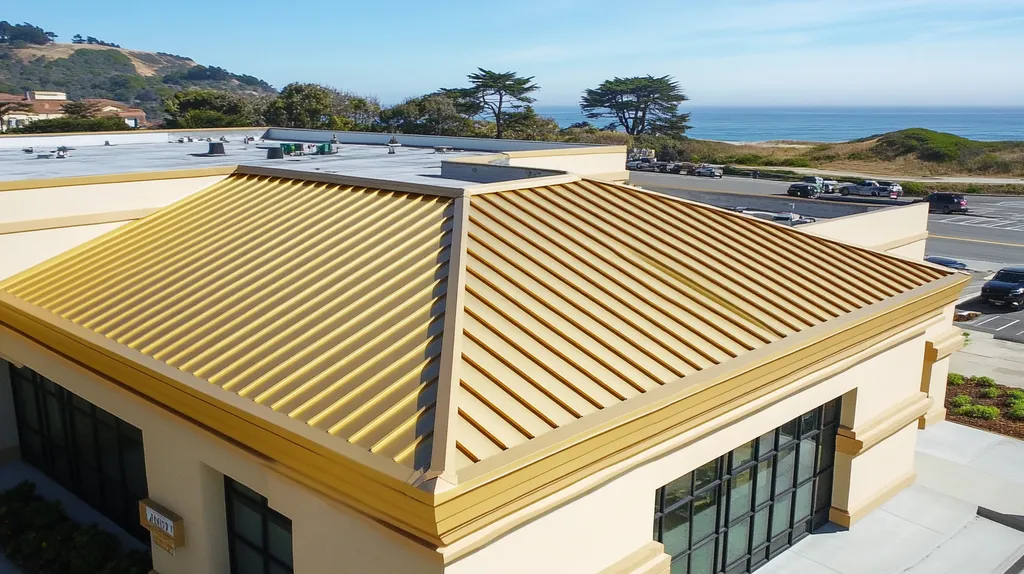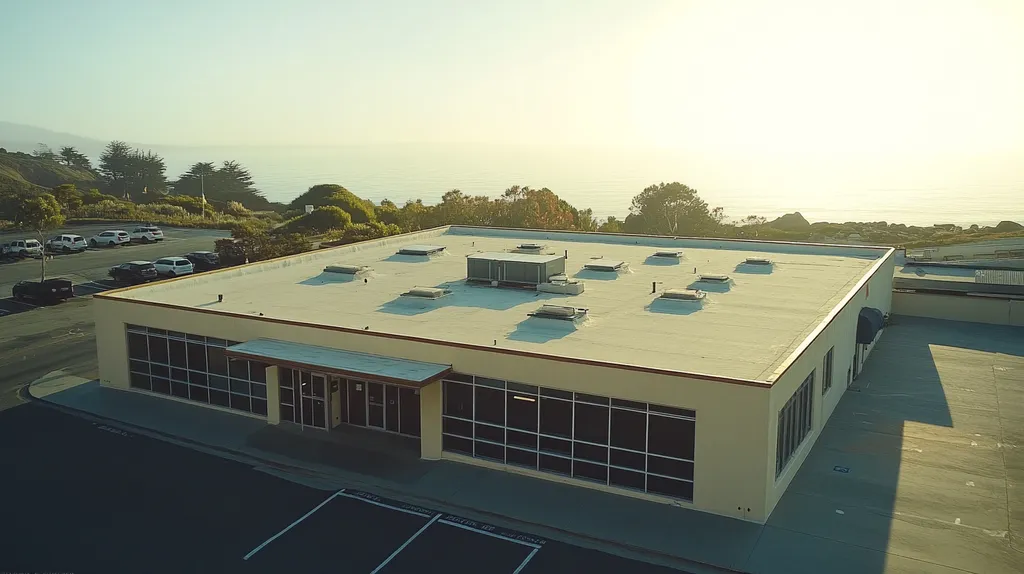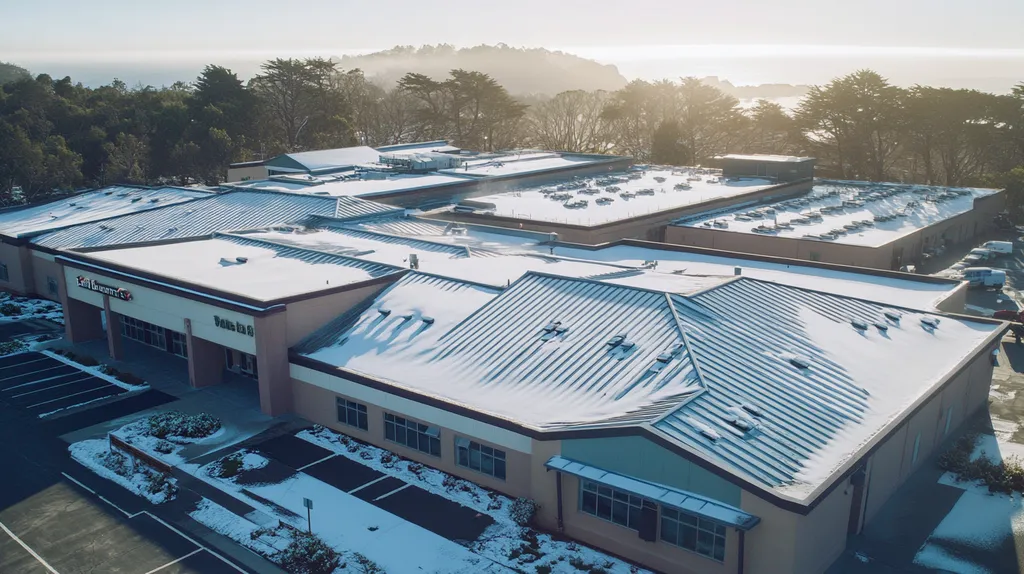Industrial fires caused by roofing system failures result in over $3 billion in annual losses, yet widespread misconceptions about fire ratings continue putting facilities at risk.
From misinterpreting basic classifications to overlooking critical assembly components, these misunderstandings create dangerous vulnerabilities that can render expensive roofing systems ineffective during emergencies.
This analysis examines six key areas where fire rating myths impact industrial buildings, providing facility managers with essential guidance for making informed roofing decisions that protect both assets and lives.
SECTION 1: COMMON MISCONCEPTIONS
Fire-related incidents cost industrial facilities billions annually, with roof assemblies playing a critical role in fire protection. Unfortunately, widespread misconceptions about fire ratings lead to dangerous vulnerabilities in industrial buildings. Understanding these ratings isn’t just about compliance—it’s about protecting assets, operations, and lives. Let’s examine three pervasive myths that continue to impact roofing decisions.
Misinterpreting Class A, B, and C Fire Ratings
The distinction between fire rating classes is more nuanced than many realize. Class A, B, and C ratings reflect different levels of protection against external fire exposure, determined through rigorous testing procedures.
Class A ratings, requiring flame spread less than 6 feet during a 10-minute test with a 1400°F flame, represent the highest level of fire resistance. However, this doesn’t automatically make them the only viable choice for every application.
Each rating class serves specific purposes based on building use, occupancy type, and local code requirements. The key is matching the appropriate rating to the facility’s specific fire risk profile.
Testing procedures for these classifications involve precise measurements of flame spread, intermittent flame exposure, and burning brand resistance. (source: National Gypsum Company)
Assuming Fire Ratings Apply Only to Roof Coverings
Fire ratings encompass entire roof assemblies, not just the exterior covering. This includes everything from deck materials to insulation layers and vapor barriers.
Each component in the roofing system must work together to achieve the designated fire rating. A single incompatible material can compromise the entire assembly’s fire resistance.
Installation methods and system integration are equally crucial. Proper fastening, seaming, and detail work all contribute to maintaining the intended fire resistance level.
Regular inspection and maintenance of all roofing components help ensure the assembly maintains its fire rating throughout its service life.
Belief That Fire Ratings Are Universal Nationwide
Fire rating requirements vary significantly by jurisdiction, climate zone, and building use. What’s acceptable in one location may not meet code requirements in another.
Local building codes often modify national standards based on regional factors such as wildfire risk, proximity to other structures, or specific industrial activities.
Climate conditions can affect how roofing materials perform and maintain their fire resistance over time. Hot, dry regions may require different specifications than areas with frequent precipitation.
Facility managers must consider both national standards and local requirements when selecting roofing systems. This ensures compliance while providing appropriate protection for specific regional challenges.
SECTION 2: PRACTICAL IMPLICATIONS
Fire ratings directly impact building safety, insurance costs, and long-term property value. Industrial facilities face increasing scrutiny over their fire protection measures, with roof assemblies being a critical component. Recent data shows that inadequate fire ratings contribute to over $3 billion in annual industrial property losses. Understanding how these ratings affect material choices and compliance requirements is essential for making informed roofing decisions.
How Fire Ratings Influence Roof Material Selection
ASTM E108 testing requirements establish clear performance criteria for roofing materials, determining their fire resistance capabilities under severe, moderate, and light fire exposures. Testing simulates real-world conditions including wind effects and burning brand exposure to ensure reliable performance ratings. (source: Intertek)
Material selection must balance initial costs against long-term protection needs. While Class A materials typically command premium prices, their superior fire resistance often translates to reduced insurance premiums and maintenance costs.
The choice of fire-rated materials affects the entire building envelope’s performance. Incompatible materials or improper installation can compromise even the highest-rated systems, making proper specification crucial.
Regular inspection and maintenance programs help ensure fire-rated materials maintain their protective capabilities throughout their service life.
Impact of Local Building Codes on Fire Rating Requirements
Local jurisdictions frequently modify baseline requirements based on specific regional risks and building density. Urban areas typically mandate stricter fire ratings due to increased exposure risks from adjacent structures.
Code compliance involves more than selecting appropriately rated materials. Installation methods, system integration, and ongoing maintenance all factor into meeting local requirements.
Failing to meet local code requirements can result in significant penalties, including work stoppages, fines, and potential liability issues. Some jurisdictions require third-party verification of fire ratings before issuing occupancy permits.
Property owners must consider both current requirements and potential future code changes when planning roof installations or replacements.
Fire Ratings and Their Role in Wildfire-Prone Regions
Wildfire zones demand exceptional attention to fire rating selection and implementation. These areas often require Class A materials exclusively, with additional provisions for ember protection and thermal barriers.
The interface between roof assemblies and other building components becomes critical in wildfire scenarios. Proper detailing around vents, edges, and penetrations helps maintain the integrity of fire-rated systems.
Insurance carriers in wildfire-prone regions increasingly scrutinize roofing specifications. Properties with superior fire ratings often qualify for preferred coverage terms and reduced premiums.
Climate change impacts have expanded traditional wildfire zones, making fire rating considerations relevant to previously low-risk areas. Forward-thinking facility managers now incorporate wildfire resistance into their roofing strategies regardless of current risk assessments.
SECTION 3: COST OF MISINFORMATION
The financial consequences of misunderstanding fire ratings can be devastating for industrial facilities. Each year, properties suffer millions in preventable losses due to inadequate roof fire protection. Beyond direct fire damage, choosing incorrect ratings creates a cascade of expenses through regulatory penalties, insurance complications, and operational disruptions that can cripple even well-established businesses.
Financial Risks of Choosing Incorrect Fire Ratings
Roofing systems must meet specific fire rating requirements to protect both physical assets and financial investments. Insufficient ratings can void warranties and insurance coverage, leaving facility owners fully exposed to loss.
When fire incidents occur, improperly rated roofs often result in total system failure rather than contained damage. This transforms manageable repair costs into complete replacement scenarios, often exceeding million-dollar thresholds.
Emergency remediation of non-compliant systems typically costs 3-5 times more than proper initial installation. This includes not just materials and labor, but also production downtime and temporary facility modifications.
Legal exposure from incorrect ratings extends beyond direct damage to include liability for impacts on neighboring properties and business interruption claims from tenants or clients.
Consequences of Non-Compliance with Code Requirements
Roofing systems must meet or exceed building codes and insurance requirements, with ratings covering both external and internal fire exposure. Class A rated roofs typically meet the strictest standards, providing maximum protection and compliance assurance. (source: Buildings.com Industry News)
Code violations often trigger immediate cease-operation orders until proper ratings are achieved. These shutdowns average 2-3 weeks for minor corrections and can extend to months for major remediation.
Local authorities may impose daily fines until violations are corrected, quickly accumulating into substantial penalties. These costs compound with legal fees and mandatory third-party inspections.
Non-compliance can also trigger loan covenant violations, potentially forcing immediate repayment of construction or renovation financing.
Increased Insurance Costs Due to Insufficient Fire Protection
Insurance carriers routinely increase premiums by 25-40% for facilities with inadequate fire ratings. Some carriers may decline coverage entirely, forcing reliance on high-risk insurers at premium rates.
Claims involving non-compliant roofing systems often face extensive scrutiny and potential denial. This leaves facility owners responsible for both the damage and ongoing premium increases.
The impact extends beyond property insurance to business interruption coverage. Carriers may restrict or eliminate this crucial protection when fire ratings fall short of requirements.
Risk assessments considering insufficient ratings can affect coverage across multiple policies, creating a compound effect on total insurance costs.
SECTION 4: REALITY CHECK
Recent data shows that over 40% of industrial fire losses involve roof assemblies, yet many facility managers remain uncertain about critical fire rating factors. Understanding these ratings requires more than simply checking a box for compliance—it demands knowledge of complex testing procedures, component interactions, and varying enforcement standards. As industrial facilities face increasing scrutiny over fire safety measures, the stakes for getting these ratings right have never been higher.
Understanding Fire Test Methods
ASTM E108 fire testing evaluates roof coverings through three distinct classifications reflecting different levels of fire exposure severity. Class A ratings address severe fire conditions, Class B moderate exposure, and Class C light exposure, with each classification requiring specific performance criteria under simulated external fire and wind conditions. (source: Intertek)
The Spread of Flame test measures how quickly fire travels across roofing materials, simulating real-world conditions where flames can rapidly engulf large areas. This test becomes particularly crucial in dense industrial parks where fire spread between buildings poses significant risks.
Intermittent Flame testing evaluates material response to direct flame contact, helping predict performance during exposure to sporadic fire conditions. This assessment proves especially valuable for facilities with frequent hot work operations or spark exposure.
Burning Brand testing simulates falling embers or hot debris, measuring a roof’s resistance to ignition from above. This evaluation gains importance in areas near wildland interfaces or facilities with elevated fire risks from neighboring operations.
Importance of Roof Assembly Components Beyond the Covering
A roof’s fire resistance depends on the coordinated performance of multiple layers working together as an integrated system. Even minor modifications to any component can compromise the entire assembly’s fire rating.
Insulation choices significantly impact overall fire performance, with some materials contributing to rapid flame spread despite being covered by fire-rated membranes. The interaction between insulation and covering materials requires careful consideration during specification.
Penetrations, flashings, and termination details create potential weak points in fire-rated assemblies. These transitions demand proper design and installation to maintain the system’s integrity during fire exposure.
Support structures and deck materials contribute substantially to fire performance, affecting both the spread of flames and structural stability during fire events. Regular inspection of these components helps ensure ongoing rating compliance.
Variations in Fire Rating Enforcement Across Jurisdictions
Local authorities interpret and enforce fire rating requirements differently, creating a complex landscape for multi-location facility managers. What passes inspection in one jurisdiction may fail in another, necessitating careful attention to local standards.
Urban areas typically enforce stricter interpretations of fire rating requirements due to building density and exposure risks. These enhanced standards often exceed baseline national requirements, particularly in zones with high-value industrial operations.
Rural jurisdictions may lack resources for comprehensive enforcement, potentially creating false security about compliance. This situation requires facility managers to maintain higher internal standards rather than relying solely on local oversight.
Climate zones and regional fire risks influence how authorities approach enforcement. Areas prone to wildfires or severe weather often implement additional requirements beyond standard fire rating criteria.
SECTION 5: EVIDENCE-BASED ALTERNATIVES
Industrial facility fires caused by inadequate roofing systems result in billions in annual losses. Recent industry data shows that upgrading to proven fire-resistant alternatives can reduce fire-related incidents by up to 70%. Yet many facilities continue relying on outdated materials and methods that create unnecessary vulnerabilities. Understanding and implementing evidence-based roofing alternatives isn’t just about code compliance—it’s about protecting valuable assets and human lives.
Utilizing Fire-Resistant Underlayments and Insulation
ASTM E108 testing demonstrates that proper underlayment and insulation choices significantly impact a roof’s ability to resist fire spread under severe exposure conditions. Materials must perform effectively during wind conditions while preventing flame penetration through the roof assembly. (source: Intertek)
Mineral wool and glass-fiber insulation materials provide superior fire resistance while maintaining thermal efficiency. These materials can withstand temperatures exceeding 1,800°F without compromising structural integrity.
Modern underlayment systems incorporate intumescent properties that expand when exposed to heat, creating additional protective barriers. This reactive capability adds crucial minutes to evacuation time during fire events.
Installation methods for these materials require precise attention to detail, particularly around penetrations and transitions. Even minor gaps can compromise the entire system’s fire resistance.
Benefits of Non-Combustible Roof Deck Materials
Steel and concrete deck systems provide foundational fire resistance that enhances overall roof assembly performance. These materials maintain structural integrity during fire exposure while preventing flame spread to building interiors.
Modern lightweight concrete compositions offer improved thermal properties without sacrificing fire resistance. This advancement addresses historical concerns about excessive dead loads on building structures.
Properly detailed metal deck systems create natural fire breaks that compartmentalize potential incidents. This containment capability proves especially valuable in facilities with large roof areas.
Regular inspection protocols for non-combustible decking help identify potential compromises before they impact fire resistance. This proactive approach extends system longevity while maintaining safety performance.
Selecting Membranes and Coatings That Enhance Fire Performance
Advanced membrane materials incorporate fire-retardant compounds throughout their composition rather than relying on surface treatments alone. This integrated approach maintains fire resistance even as the membrane weathers.
Thermoplastic and modified bitumen systems offer proven fire resistance while providing excellent weathering characteristics. These materials create seamless barriers that resist both flame spread and burning brand penetration.
Specialized coating systems can upgrade existing roof assemblies to meet higher fire ratings. This retrofit capability offers cost-effective compliance solutions for older facilities.
Regular recoating programs maintain fire resistance while extending overall system life. Documented maintenance protocols help facility managers track performance and plan future upgrades.
SECTION 6: TEST AND VERIFY
Fire rating verification failures contribute to over $500 million in preventable industrial roof damage annually. Despite clear testing standards and certification processes, many facility managers rely on incomplete or outdated verification methods. This oversight creates significant liability exposure while compromising safety measures designed to protect valuable assets and human lives.
Verifying UL 790 and ASTM E108 Certification Labels
ASTM E108 testing protocols establish rigorous standards for evaluating roof coverings through Spread of Flame, Intermittent Flame, and Burning Brand tests. Certification marks like ETL or Warnock Hersey provide documented proof of compliance with these critical safety standards. (source: Intertek)
Labels must clearly indicate both the testing standard and classification level achieved. Verification requires examining actual materials rather than relying solely on specification documents or contractor assurances.
Material certification records should be maintained throughout the roof’s service life. These documents become crucial during insurance audits and post-incident investigations.
Regular verification of certification status helps identify potential classification changes or manufacturer updates that could affect system performance.
Conducting On-Site Assessments for Fire Rating Compliance
Physical inspection programs must evaluate complete roof assemblies rather than individual components. This includes examining installation methods, penetration details, and system interfaces that affect fire performance.
Assessment protocols should incorporate thermal imaging and moisture surveys to identify hidden conditions that could compromise fire ratings. These technologies help detect deterioration before it affects system performance.
Documentation of assessment findings creates an essential record of system condition and compliance status. This information supports maintenance planning while providing evidence of due diligence.
Regular assessments help identify emerging issues before they create significant vulnerabilities. Early detection allows for targeted repairs rather than extensive replacements.
Using Third-Party Testing and Documentation for Validation
Independent testing provides objective verification of fire rating compliance. This process eliminates potential conflicts of interest while ensuring thorough evaluation of all system components.
Testing protocols must simulate actual service conditions including environmental exposure and mechanical stress. These factors significantly influence long-term fire rating performance.
Documentation packages should include detailed test reports, photographic evidence, and specific recommendations. This comprehensive approach supports informed decision-making about system maintenance and upgrades.
Third-party validation creates a defensible record of compliance efforts. This documentation proves invaluable during regulatory inspections and insurance reviews.
The Bottom Line
With industrial roof fires causing over $3 billion in annual losses, the cost of misunderstanding fire ratings has never been higher.
Proper fire rating selection and verification represents the difference between contained incidents and catastrophic failures that can destroy entire facilities.
Property owners and facility managers must move beyond outdated assumptions about fire ratings, recognizing that true protection comes from properly tested assemblies, not individual components.
Success requires understanding local code variations, implementing comprehensive testing protocols, and maintaining thorough documentation of compliance efforts.
In an era of increasing fire risks and stricter regulations, getting fire ratings right isn’t just about meeting codes—it’s about ensuring business survival.
FREQUENTLY ASKED QUESTIONS
Q. What are common misconceptions about fire ratings for commercial roofs?
A. Many believe that Class A ratings are the best choice for all situations. However, each class serves specific needs based on fire risk. Understanding these distinctions helps match the best rating to each building type.
Q. How do fire ratings impact industrial roof material selection?
A. Fire ratings dictate which materials are appropriate based on their resistance levels. Selecting materials based on these ratings can avoid costly long-term consequences and ensure overall safety of the structure.
Q. What are the financial risks of using incorrect fire ratings?
A. Using incorrect fire ratings can lead to significant financial liabilities, including insurance claim denials and costly repairs. These risks turn manageable situations into severe financial burdens that can jeopardize the business.
Q. Why do fire rating enforcement levels vary for industrial roofs?
A. Enforcement varies due to local building codes influenced by factors such as population density and environmental risks. Understanding these variances is crucial for compliance across different facility locations.
Q. How can facility managers utilize fire-resistant underlayments?
A. Fire-resistant underlayments significantly enhance overall fire protection and performance under severe conditions. Proper installation is key to ensuring that these materials work effectively to safeguard the facility.
Q. How can I verify fire rating compliance for my roof?
A. Fire rating compliance can be verified by checking for ASTM certification labels and conducting thorough inspections. Regular assessments help ensure ongoing compliance and protect against future liabilities.
Q. What are the consequences of poor fire rating awareness in facilities?
A. Poor awareness can lead to extensive property damage, increased insurance costs, and legal liabilities. Recognizing fire ratings is essential for protecting both people and assets within industrial facilities.










